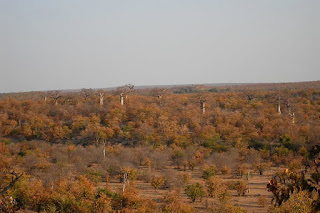The title of this blog will only be funny to those midwesterners familiar with Kroger's. If you don't know what I'm talking about, don't even worry about it. It won't be the first time that you'll have no idea what I'm talking about, I can promise you that much. Long explanation longer, this entry will be all about Kruger National Park! As if working with cheetahs for a month isn't cool enough, I also get to go on a weekend safari in Kruger National Park as part of the program. Kruger is up in the Limpopo province. Here's a map:
Kruger National Park is as big as it looks. Actually, it's a lot bigger than it looks. It is South Africa's largest game preserve, covering 19,485 square kilometers (12,100 square miles / 4814848 acres). It extends 220 miles from north to south and 40 miles from east to west. It is part of the Great Limpopo Transfrontier Park, which is a peace park that links Kruger with the Gonarezhou National Park in Zimbabwe and with the Limpopo National Park in Mozambique.
Kruger National Park can trace its origins back to 1898 when Paul Kruger, president of the Transvaal Republic, declared the area a "Government Wildlife Park". In case, like me, you were wondering what the Transvaal Republic is, I'll fill you in: The Transvaal Republic is the informal name used for the South African Republic, which was an independent Boer-ruled country in South Africa during the mid-19th century. The Transvaal Republic IS NOT the same thing as the Republic of South Africa (There is a lot of history going unsaid here, but any more detail will be saved for a later day and a different fact). This Government Wildlife Park was named the Sabi Game Reserve. The park was originally created to control hunting and protect the diminished number of animals in the area.
By 1926, the Sabie Game Reserve, the Shingwedzi Game Reserve and farms were combined to create Kruger National Park. In 1959, Warden Sadenburg decided to fence in the entire reserve in an attempt to curb the spread of disease, facilitate border patrols, and inhibit poachers. The Makuleke area in the northern part of the park was forcibly taken from the Makuleke people by the government in 1969, and was not returned to them until 1996.
The vegetation of Kruger is separated into four main types:
Thorn trees and Red Bush-willow veld
 |
| Red Bush-willow |
 |
| Acacia Tree |
Knob thorn and Marula veld
 |
| Knob Thorn |
 |
| Marula |
Red bush-willow and Mopane veld
 |
| Mopane Forest |
Shrub Mopane veld
 |
| Shrub Mopane |
I'd really like to see some baobabs while I'm there as well, and it seems as if that wish will be fulfilled...this picture was taken in Southern Kruger:
 |
| Baobab Tree! |
As for animals, the BIG FIVE game animals are found at Kruger. These include the lion, African Elephant, cape buffalo, leopard, and rhinoceros. Kruger also hosts more species of mammals than any other African Game Reserve, coming in at 147 different species. What I find to be incredibly exciting is the fact that Kruger hosts packs of the endangered African Wild Dog, which is one of my favorite animals, just because they are so odd-looking. There are thought to only be about 400 of these crazy looking animals left in all of South Africa.
 |
| African Wild Dog |
Kruger is also home of the viral YouTube Video "Battle at Kruger". If you haven't seen it yet, then check it out.
Okidoke, cheetah time! The Kruger National Park is an important refuge for our spotted feline friends. The cheetahs are very shy, however, and sightings are pretty rare. There are about 100 cheetahs that call Kruger home. They are important because they have demonstrated that cheetahs can adapt well to a densely wooded environment, as opposed to their traditional habitat of large open spaces in the Serengeti. It would be amazing to see a cheetah in the wild...we'll see what happens!

No comments:
Post a Comment